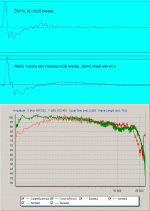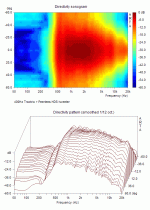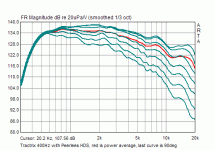I would like to be put on the list for (6) of the waveguides. I have previously built several horn loaded cabinets using a tractix type horn, for my 7.1 home theatre system. Am looking for that last bit of quality. These will be used to replace the current horns, and hopefully retire into surround heaven.
Does the list have enough buyers yet ??? I see this link has kinda stalled ??? I am READY to purchase immediately. Could someone please advise on the progress of the group buy ??
Thanks........ J. L.
Does the list have enough buyers yet ??? I see this link has kinda stalled ??? I am READY to purchase immediately. Could someone please advise on the progress of the group buy ??
Thanks........ J. L.
Changes in my situation may not allow me to agree to the prices etc. that I quoted before - that was a long time ago. I can still provide all the required parts, but I may not be able to get them from the same suppliers and so I can't quote prices until I actually go to buy the parts.
There has not been any activity on this thread in a long time. I don't think that the "group buy" worked out. If you really want these parts then I would suggest contacting me directly at egeddes@gedlee.com and we might be able to work something out.
There has not been any activity on this thread in a long time. I don't think that the "group buy" worked out. If you really want these parts then I would suggest contacting me directly at egeddes@gedlee.com and we might be able to work something out.
Third order high pass and low pass optimized for best power response through the crossover region - basically it doesn't fit any "standard" definition.
I've asked because I'm running my horn project now. 400Hz Tractrix profile with 25mm silk dome plus 38cm woofer which is flat to 3kHz and breakup is gentle. Tractrix HP slope is about 24dB/oct so that LR crossover would be just fine if distortion and off-axis is ok. Transient perfect crossovers have some lobes off axis. I'm not sure - this is because of driver spacing and subtractive mode? Acoustic centre in my design can be adjusted - woofer is placed upwards on Sonotube with weight and horn is just few cm above in the mid point. Target efficiency is 104dB/1W/1m.
Ok. it looks like horns are extremely sensitive for pressure response irregularities. I've found DSP removes horn honking considerably. Without special treatment just proper gasket with wool around dome tweeter (Peerlees HDS) I've got good results. Please see my comparison with ESP15.
Attachments
Your measurements don't look quite like mine for the ESP15. But at any rate, you need to show polar responses NOT axial responses. The ESP line is not optimized for its axial response. I would not expect the polar responses for a tractrix horn to be as good as those for the OS.
I apologise my measurement is faulty because the rotational centre 2" from throat not at the mouth midpoint. So extreme angle is now 90deg and some normalisation is necessary. I need special turntable for that.
jzagaja said:Dear Dr Geddes,
By off-axis optimisation in crossover you mean power average right?
Not exactly, but thats the idea. I design for the best average response up to about 30°, which is not really the total power response.
Excuse me if this is proprietary, but do you just a bunch of measurements up to 30º off axis, average that and use the average curve for designing your crossover?
That was my thoughts on how to approach it anyway. But I've never designed a speaker before.
That was my thoughts on how to approach it anyway. But I've never designed a speaker before.
Dear Earl,
Summa doc is no longer available so could you tell me what do you think about off-axis response of my horn?
Summa doc is no longer available so could you tell me what do you think about off-axis response of my horn?
JoshK said:Excuse me if this is proprietary, but do you just a bunch of measurements up to 30º off axis, average that and use the average curve for designing your crossover?
That was my thoughts on how to approach it anyway. But I've never designed a speaker before.
Thats the basic idea, but it is done more by eye I suppose than a precise mathematical algorithm.
The point is that I DON'T EQ to a flat on-axis response ignoring all else (as is done in about 99% of all speaker designs).
That always seemed the smartest way to me and I never understood why it wasn't always done that way (I am just learning measurement basics). I certainly don't have my speakers pointed right at me so why is 0º the design axis anyway if you *were* to only choose a reference axis to design from? And that reference angle would be different from setup to setup for most folks. It seems that some average (or weighted average) of included angles of measurement would be far more ideal.
And regarding the eyeball versus algorithmic approach, I am with you. My education was in statistics and math, but in my field of work I am an empiricist. I work with far too many phd types that eschew intuition and fundamental insights for hard mathematical approaches, but they typically never last as long in my field.
And regarding the eyeball versus algorithmic approach, I am with you. My education was in statistics and math, but in my field of work I am an empiricist. I work with far too many phd types that eschew intuition and fundamental insights for hard mathematical approaches, but they typically never last as long in my field.
Your points are true, but not the most important ones. The reason that I use only the first 30° is that in my systems that includes just about all of the sound power above about 500 Hz - they have a very narrow directivity. What we hear is far more than the direct sound and many people would argue that the direct sound is only a small fraction of the perceived sound. So why EQ to that even if it is at 0°? True constant and narrow directivity is the only logical solution. Nothing else stands up to any serious critical analysis.
jzagaja said:Dear Earl,
Summa doc is no longer available so could you tell me what do you think about off-axis response of my horn?
See Attached
I can't comment on you device without seeing how it works in the system.
Attachments
- Home
- Loudspeakers
- Multi-Way
- Geddes on Waveguides


